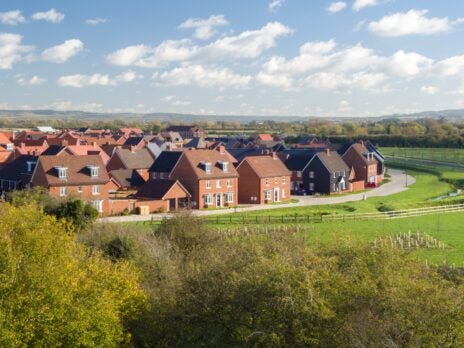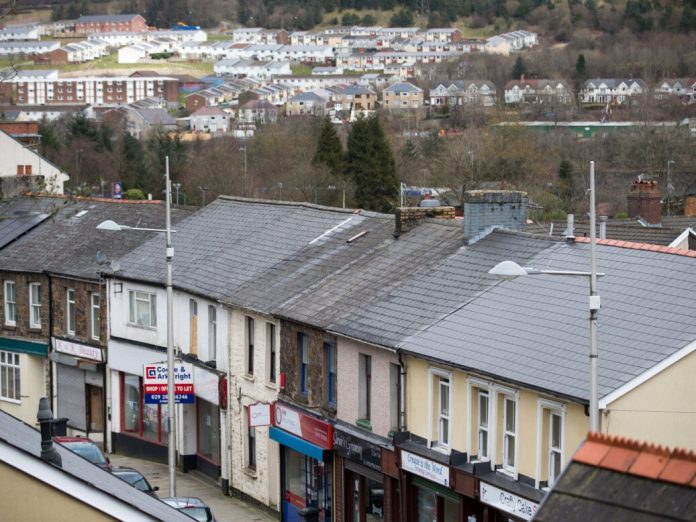The Ebbw Vale high street in Blaenau Gwent, which is an area of Wales that has seen a decline in its population, according to the latest census. Photo by Matt Cardy/Getty Images.
The first release of census data for England and Wales this summer has revealed that the UK’s population is likely to cross the 70 million milestone in the next five years. The current number of inhabitants is almost 67 million, when the 1.9 million recorded in Northern Ireland’s census is added to the 59.6 million found in England and Wales, along with the 5.5 million that is the latest estimate for Scotland.
The population of England and Wales has grown by 19.4 per cent over the past three decades, from a total of 49.9 million recorded in 1991. But this headline figure masks a huge range of population changes within the two countries’ 173 smaller regions, the population densities of which are also recorded in the census and displayed on the map below. Shifts between these locales reveal much about regional development over the past three decades, from the close of Thatcherism through to New Labor and the post-Brexit era.
As would be expected given the significant population growth experienced over the past three decades, in most places the number of residents increased. Nevertheless, 11 regions saw their population density fall. The greatest fall, at 7.1 per cent, was seen in Blaenau Gwent, a Welsh community that has lost both coal pits as well as the Ebbw Vale steelworks, formerly the largest such site in Europe, which shut in 2002.
The majority of the other regions that witnessed depopulation are also former industrial hubs, including South Tyneside, Redcar and Sunderland. Blackpool, a seaside resort that has experienced decades of economic decline and social deprivation, also saw its population density decline. As did the Isle of Anglesey, a region with a rapidly aging population, that saw its share of people aged 65 years and over increase by 16.3 per cent and people aged 15 to 64 years decrease by 7.9 per cent in just the past decade.
Sign up for The New Statesman’s newsletters
Tick the boxes of the newsletters you would like to receive.
Morning call
Quick and essential guide to domestic and global politics from the New Statesman’s politics team.
the crash
A weekly newsletter helping you fit together the pieces of the global economic slowdown.
World Review
The New Statesman’s global affairs newsletter, every Monday and Friday.
The New Statesman Daily
The best of the New Statesman, delivered to your inbox every weekday morning.
GreenTimes
The New Statesman’s weekly environment email on the politics, business and culture of the climate and nature crises – in your inbox every Thursday.
The Culture Edit
Our weekly culture newsletter – from books and art to pop culture and memes – sent every Friday.
Weekly highlights
A weekly round-up of some of the best articles featured in the most recent issue of the New Statesman, sent each Saturday.
Ideas and Letters
A newsletter showing the finest writing from the ideas section and the NS archive, covering political ideas, philosophy, criticism and intellectual history – sent every Wednesday.
Events and Offers
Sign up to receive information regarding NS events, subscription offers & product updates.
Job title Administration / Office Arts and Culture Board Member Business / Corporate Services Client / Customer Services Communications Construction, Works, Engineering Education, Curriculum and Teaching Environment, Conservation and NRM Facility / Grounds Management and Maintenance Finance Management Health – Medical and Nursing Management HR, Training and Organizational Development Information and Communications Technology Information Services, Statistics, Records, Archives Infrastructure Management – Transport, Utilities Legal Officers and Practitioners Librarians and Library Management Management Marketing OH&S, Risk Management Operations Management Planning, Policy, Strategy Printing, Design, Publishing, Web Projects, Programs and Advisors Property, Assets and Fleet Management Public Relations and Media Purchasing and Procurement Quality Management Science and Technical Research and Development Security and Law Enforcement Service Delivery Sport and Recreation Travel, Accommodatio n, Tourism Wellbeing, Community / Social Services
At the other end of the spectrum, three neighboring local authorities in central east London – the City of London, Tower Hamlets and Newham – saw their population densities increase by 107.6 per cent, 92.7 per cent and 65.5 per cent, respectively. The City’s economy has boomed since the 1990s, is now worth £70bn, and is home to one in three UK financial services jobs. Tower Hamlets holds the UK’s other great financial centre, Canary Wharf, and both it and Newham have seen massive investment and development resulting from the 2012 Olympics.
But it is not only parts of the capital that have grown more densely populated in a significant way. The likes of Lincolnshire, South Gloucestershire, Northamptonshire, Milton Keynes and Oxfordshire have all seen their populations grow by more than 30 per cent.
Content from our partners



“Sandwiched between the city of Bristol, the rolling Cotswold hills and the mighty River Severn, we are the economic engine room of the west of England, generating a higher per capita GDP than anywhere outside the City of London,” a South Gloucestershire Council spokesperson said. They added that the number of households in South Gloucestershire has increased by 10 per cent since the last census, which is a higher increase than seen in the majority of England and Wales.
Colin Davie, executive councilor for economy at Lincolnshire County Council, added that his region attracted those looking for a lower cost of housing and living than the rest of the country, as well as a high quality of life. He added that the 1992 establishment of the University of Lincoln, which now has more than 16,000 students, as well as the settlement of many seasonal farm workers in a region that produces one eighth of England’s food, have also contributed to the boom.
[See also: Can the Greens become more than a single MP party in England and Wales?]

